
A trail in Paradise, Mount Rainier National Park / Rebecca Latson
Back in September, Part 1 of this Armchair Photography Guide to Mount Rainier National Park took you to photo ops in the Sunrise area, with tips on gear, techniques, times and seasons. October’s Part 2 led you along Stevens Canyon Road, stopping at waterfalls, alpine lakes, wildflower spots and panoramic vistas of Mount Rainier and the Tatoosh mountain range. This month’s Part 3 will guide you through the spiderwebbed network of Paradise trails, chock full of photo ops. To familiarize yourself with the layout, download this map.
Let's begin this tour with a little bit of interior architectural photography. While you may roll your eyes at the prospect of capturing an image of anything manmade amongst the wildflowers, scenery and wildlife, I urge you to rethink the possibilities while wandering through both the Henry M. Jackson Visitor Center and the historic Paradise Inn (which celebrated its centennial birthday earlier this year). These impressive structures are part and parcel of this national park and provide great opportunities for interior shots.
Henry M. Jackson Visitor Center

Looking down the trail at the Henry M. Jackson Visitor Center, Mount Rainier National Park / Rebecca Latson

Welcome to Paradise, Mount Rainier National Park / Rebecca Latson
Walk in to the welcoming open area of the visitor center, with its tall windows and healthy infusion of natural light, to take the elevator or the stairs up to the open second level. From there, use your wide-angle lens to get shots of the lobby. Because of the inevitable crowds, you might want to leave behind your tripod in favor of simply handholding your camera. Increase your ISO anywhere from 640 to 800, choose an aperture of between f5.6 and f7.1 and reduce your shutter speed to 1/50 – 1/30 of a second. Note: the camera settings I give in this guide are not the gospel, but rather a go-by. Experiment on your own for the look you like best.
I advise not using a flash, since it wouldn’t carry that far over the expanse of the building’s interior and it might override the effects of the beautiful light streaming through the windows. If your lens or camera possesses image stabilization, turn that on. Since your shutter speed is going to be relatively slow (depending upon what your ISO is), you might even need to apply the “burst method”, which is simply holding your finger down on the shutter button for several continuous shots. It’s jokingly referred to as “spray and pray”. The theory is that, out of several shots, at least one will turn out sharp and clear. Hey, this method works, so don’t dis it too much.

A wide-angle view of the visitor center lobby, Mount Rainier National Park / Rebecca Latson
Remain on the second level a little longer to aim your camera out one of the large picture windows facing Mount Rainier. The window panes provide interesting little frames to the scene. Adjust your camera’s settings for photographing the bright outdoors by changing the ISO to 200 - 320, with an aperture of f9 and a shutter speed to 1/125. Again, remember these settings are go-by and not gospel.
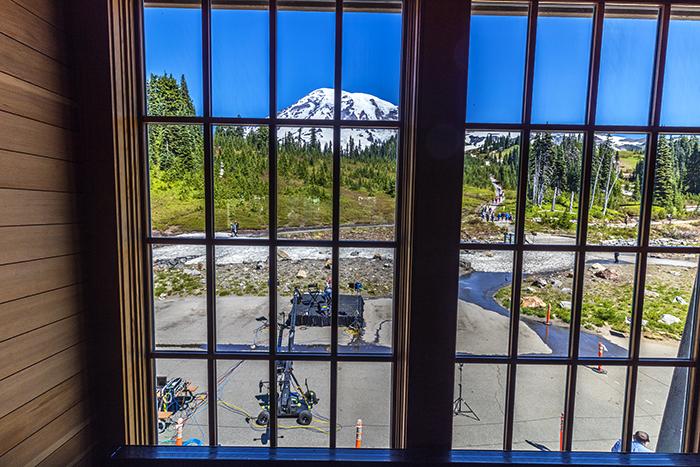
A look out the window, Henry M. Jackson Visitor Center, Mount Rainier National Park / Rebecca Latson

Celebrating a century at the Paradise Inn, Mount Rainier National Park / Rebecca Latson
Paradise Inn
As you walk around this historic piece of architecture, looking for scenes of interest to you, remember that the beauty of anything, interior or exterior, is not just the result of camera settings, but also how you frame your composition. You don't need to be born with an "artist's eye". SImply put a little care and thought into your subject arrangement before clicking the shutter button.
You’ll apply similar camera settings as those used for photographing the interior of the visitor center. There is more dark wood and dimmed interior settings to deal with at the inn, so you might need to ratchet up the ISO a bit more. Yes, there will be people in your shots. The Paradise Inn is a much-loved structure and people are unavoidable unless you set up camera and tripod during the wee hours of the morning. I’ve done that, and to be honest, the lobby doesn't feel quite as inviting at 3am, devoid of people and their energy. It's also a little dim without natural daylight streaming through the windows. It’s a personal preference. As you already are aware, photography is a subjective art. Whatever time you wish to photograph the Paradise Inn lobby, make sure to have your wide-angle lens ready to emphasize the distance and space from one end of the lobby to the other.

The Paradise Inn lobby in the daylight, Mount Rainier National Park / Rebecca Latson

The Paradise Inn lobby during the wee hours of the morning, Mount Rainier National Park / Rebecca Latson

A mini museum in the Paradise Inn, Mount Rainier National Park / Rebecca Latson
After you’ve finished your lobby shots, look around to see if there are any interesting exhibits. During my July stay, the inn created a sort of mini museum near the entrance, filled with WWI-era clothing.
Don't forget to check out the inn’s upper level to capture some cool shots of the wrap-around mezzanine and the lobby below. Walk up the stairs opposite the check-in desk to the second level. Turn left and you’ll see the mezzanine entrance. Your best images will be taken at either end, rather than in the middle of the mezzanine, because you'll want to encompass that long network of wooden beams and painted hanging lamps. Get both horizontal and vertical shots of this location, including a few close-ups of the hand-painted lamps, too.

The view from the Paradise Inn mezzanine, Mount Rainier National Park / Rebecca Latson
Return to the lobby, turn right to face the check-in desk, then turn right again to walk down the hallway and enter the breezeway, aka Snowbridge, leading to the Annex rooms. This breezeway is lined with wonderful historic old photos of the inn. Get some wide-angle perspectives and, if you take a notion, point your camera out one of the windows to capture the scene beyond, while still incorporating a little bit of the breezeway in your frame. Adjust your camera’s settings for the outside portion of your shot, where the light will be brighter.

A view of the Annex through a breezeway window at the Paradise Inn, Mount Rainier National Park / Rebecca Latson
A note about editing interior photos:
- Reduce highlights and shadows to lighten up your interior as well as remove any slight overexposure to the light streaming through large windows. For those of you using Adobe Lightroom, it's an easy fix with the highlights and shadows sliders.
- Apply a little bit of noise reduction software to the finished product. “Noise” refers to the black, pink and green graininess you may see in low-light, high-ISO images. Software such as Imagenomic’s Noiseware, Topaz DeNoise, Nik Dfine, or Noise Ninja, helps mitigate that grainy effect.
Now that you’ve obtained interior shots of Paradise Inn, how about going outside to photograph the exterior … at night. The interior lights’ warm glow provides a welcoming contrast to the cool, ink-blue night. All you need is a tripod and a wide-angle lens to include as much of the inn as possible in your frame. Your auto-focus should work fine as long as you aim your lens toward the lighted portions of the building. My settings for the image below were ISO 2000, f3.2, and a shutter speed of 1.6 seconds. I also applied a little noise reduction to the photo during the editing process.

1:00AM outside the Paradise Inn, Mount Rainier National Park / Rebecca Latson
Paradise Inn adds a nice reference and sense of scale to your daylight landscapes, as well.

Paradise Inn and the trail below, Mount Rainier National Park / Rebecca Latson

Heading back to the Paradise Inn on a fine autumn day, Mount Rainier National Park / Rebecca Latson
The Paradise Trails
Every trail you hike in this area produces amazing views of Mount Rainier. Stunning compositions for your camera are even accessible for those of you who may not want to hike anywhere at all. Next to the visitor center are a set of stone steps leading up to the paved Paradise trails. Before ascendinig those steps, take a moment to read the quote by John Muir carved into the stone: “… the most luxuriant and the most extravagantly beautiful of all the alpine gardens I have ever beheld in all my mountain-top wanderings.”
Walk up those steps and remain on the paved trail in front of you. If you remain near those inscribed steps, set your tripod as close to the chain links as possible separating paved trail from the meadow. This particular location nearer the visitor center is awesome in the fall, when all those huckleberry bushes change from green to brilliant shades of orange and red. This is also a nice, easily-accessed location for sunrise views of the mountain and surrounding forest.

An autumn sunrise at Paradise, Mount Rainier National Park / Rebecca Latson

Sunrise begins on the mountain, Mount Rainier National Park / Rebecca Latson
Hiking further up any of these trails treats you to unfettered views of Mount Rainier. The trails steepen, so go slowly. Take a tip from me and use your tripod as a hiking stick. With the center column extended enough for me to grab hold, my Induro-brand tripod serves double duty as a hiking staff, allowing a much easier ascent and descent for my arthritic knees.
Sunrise is lovely at Paradise. You should stake out your spot during the pre-dawn hours to allow time for any settings adjustments prior to sunrise. It's also a good idea to carry out a little locational recon the day before so you won't waste valuable pre-sunrise minutes trying to pick a good spot for your tripod. Pack along your flashlight or headlamp to prevent slips in the dark and to tweak those camera settings. I prefer a headlamp because it leaves both hands free.

Dawn's rosy glow at Paradise, Mount Rainier National Park / Rebecca Latson
Possessing a basic knowledge of your camera’s settings is essential for pre-dawn and sunrise imagery, since you’ll be altering your settings as morning lighting conditions brighten. While the sky is still a purple-indigo, you might want to start with a high ISO, anywhere from 640 – 3200, a wide-open aperture (f1.2 – f4), and shutter speeds from ¼ of a second to 10+ seconds. As the dawn breaks and the day brightens, lower your ISO (100-400), close that aperture (f6.3 - f9), and reduce your shutter speed. Make use of your grad ND filter as the sky continues to brighten while the ground remains shaded.
Avalanche Lily Trail
Ascend the inscribed stone steps across from the visitor center and turn left to follow this trail. During my July visit, both sides were carpeted with the trail's delicate, white namesake. If you are able to do so, carry along more than one lens for your trail shots. After some close-up images using my telephoto lens, I decided to get an interesting perspective of these little flowers using my 14mm lens. A close-up with a really wide-angle lens (11mm - 17mm) requires you to get practically “nose to nose” with your subject. Of course, that doesn't mean you should step off the trail and onto the delicate meadow. For the shot below, I handheld the camera and bent over low and close to the wildflowers while keeping my feet planted on the pavement.

A 14mm perspective of the Avalanche Lily Trail at Paradise, Mount Rainier National Park / Rebecca Latson
Myrtle Falls

Walking along the paved trail toward Myrtle Falls, Mount Rainier National Park / Rebecca Latson
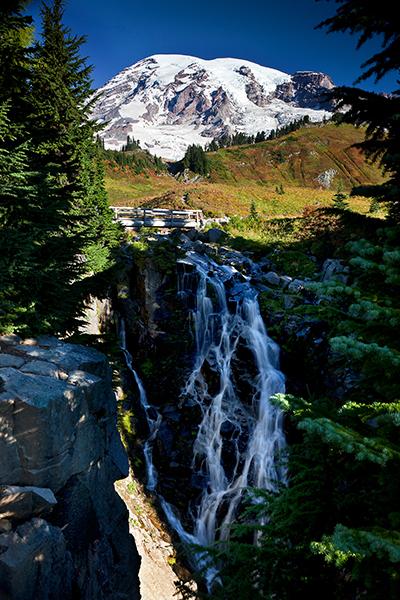
Myrtle Falls on a glorious autumn day, Mount Rainier National Park / Rebecca Latson
A short, easy walk on a paved trail from Paradise Inn to a lovely little waterfall with Mount Rainier in the background makes Myrtle Falls the most popular view point in the Paradise area. Arriving at this spot any time after 8am during a sunny day guarantees you crowds that won’t clear out until much later in the evening. When you do have long enough to set up your tripod at this spot, try out either a ND filter for a silky water shot, or a grad ND filter to tone down the bright sky and bring out the details in Mount Rainier while exposing for the shaded area around the waterfall.
Don’t despair if it’s overcast and "The Mountain" is hiding. You’ll still get gorgeous shots of Myrtle Falls and Edith Creek and there will be less of a crowd, for obvious reasons.

Myrtle Falls on a rainy September day, Mount Rainier National Park / Rebecca Latson
Return to the trail and hike a bit further to the bridge spanning Edith Creek. Set your tripod anywhere before, after, or on the bridge and capture more shots – silky water or not – of the creek (and mountain, if it's out).

The bridge over Edith Creek and Myrtle Falls, Mount Rainier National Park / Rebecca Latson

A misty, autumn morning at Edith Creek, Mount Rainier National Park / Rebecca Latson
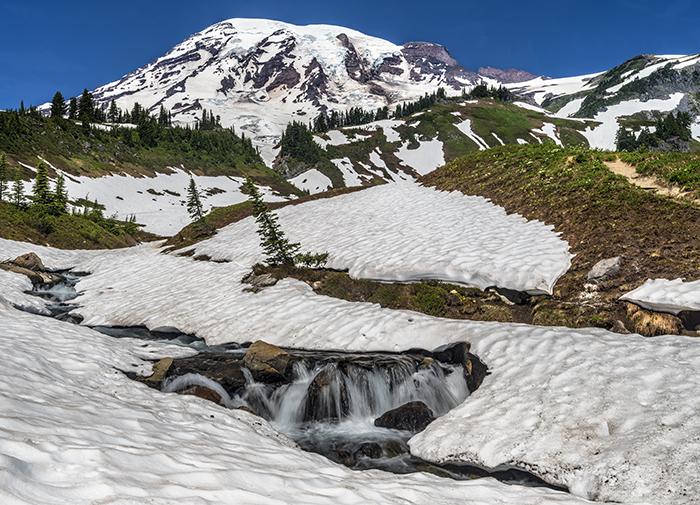
An early summer afternoon at Edith Creek, Mount Rainier National Park / Rebecca Latson
Now, turn your camera and tripod to face the other side, looking in the direction where Myrtle Falls drops off. For the image below, I used the photographic technique of "anchoring" the scene with a foreground object (the clump of wildflowers). When you use a foreground anchor, you need to think about the lens on your camera. Depending upon focal length and how close your tripod is to the subject, you'll either have the entire composition in focus (if you are using a wide-angle lens from 11mm to 17mm), or just the foreground in focus while the rest of the image is nicely bokeh'd (blurred), which will occur if you are using a lens with a shallower depth of field (35mm to 85mm). You can take 2 shots, one focusing only on the foreground anchor and the other focusing on everything else, then blend them (aka "focus stack") during your editing process. You may also stand a bit of a distance away, capture the entire composition in focus, then crop it when editing.
In addition to your focus when composing a shot, take a moment to consider your perspective, as well. Perspective depends upon your focal length and how high or low you have your tripod positioned for the shot. Experiment with a wide-angle lens, to see what I mean. Stand up for a shot, then hunker lower to the ground to see the difference.

Looking across the way from atop Myrtle Falls, Mount Rainier National Park / Rebecca Latson
Alta Vista Trail
If you don't mind parts of this trail getting a little steep, you’ll be rewarded with some awe-inspiring vistas, indeed, since Alta Vista means “high view”. On a clear day, Mount Rainier reigns over everything. On a rainy, overcast, foggy/misty day, however, you may need to concentrate on the other stunning landscapes showcased at Alta Vista, such as the deep green valleys and silver waterfalls capped by moody, low-hanging clouds.

Looking back on a portion of the Alta Vista loop, Mount Rainier National Park / Rebecca Latson
On a sunny day, apply polarizer and/or grad ND filter. Keep your ISO between 100-200, your aperture set between f9 – f16 and your shutter speed high. On a rainy day, you’ll need to make a change to those settings. Keep your grad ND filter handy because the highlights in the overcast sky and mist in the mountains will otherwise blow out (overexpose).

A wide-angle view from Alta Vista, Mount Rainier National Park / Rebecca Latson
Skyline Loop Trail
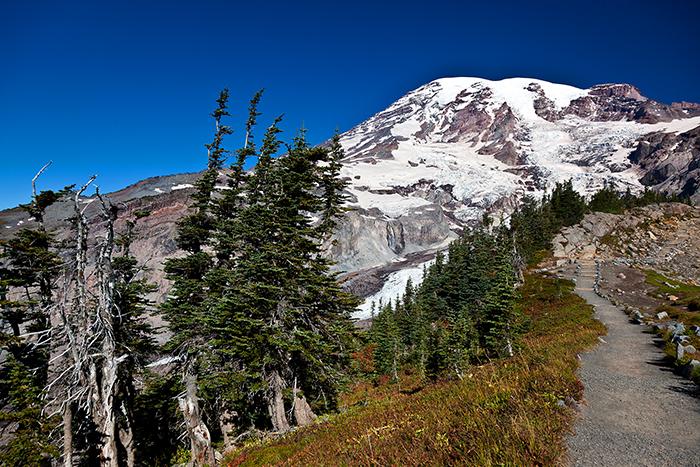
The view along the Skyline Trail, Mount Rainier National Park / Rebecca Latson
The Skyline Loop Trail is the star of the show. It’s 5.5 miles round trip and, while steep in places, is definitely worth the effort. As you hike along this trail, capture a few “personal landscapes”, such as images of the trail in front of and behind you. Include some people in your compositions. Yes, I said include people. The smallness of the people against the vastness of the landscape gives your photo viewers an even better sense of the scale of Mount Rainier’s vistas. These trail images also make great "leading line" shots, wherein the line of the trail leads the viewer's eye off into the distance of the composition's background.

Hiking the Skyline Trail on a fine autumn day, Mount Rainier National Park / Rebecca Latson
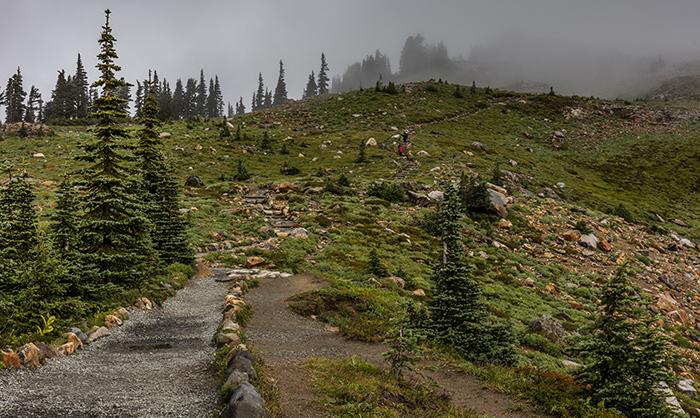
Hiking the Skyline Trail on a rainy autumn day, Mount Rainier National Park / Rebecca Latson

Onward and upward on the Skyline Trail, Mount Rainier National Park / Rebecca Latson

Looking behind me along the Skyline Trail, Mount Rainier National Park / Rebecca Latson
Along the way, Skyline trail leads to Glacier Vista and Panorama Point, both with truly amazing views on a clear day. At Glacier Vista, you can see the immensity of the Nisqually Glacier and the path it has carved. At Panorama Point, you will see Paradise Inn as a tiny speck while gazing beyond the Tatoosh mountain range toward Mount Adams and Mount Saint Helens. You might even see Mount Hood far in the distance.
The scene at Glacier Vista is a combination of light and dark, with buff-pink colored rock and debris, clean and dirty glacier ice, and dark green trees. Expose for the lighter items in your image and lighten up the dark portions of your composition during the editing process. Utilize your grad ND filter to prevent overexposure of highlights. Use your polarizer to saturate that buff-pink rock and blue sky and bring out the texture of the crags and crevasses in both mountain and glacier.

The view at Glacier Vista, Mount Rainier National Park / Rebecca Latson

A glacier with a view, Mount Rainier National Park / Rebecca Latson

The immensity of it all at Glacier Vista, Mount Rainier National Park / Rebecca Latson
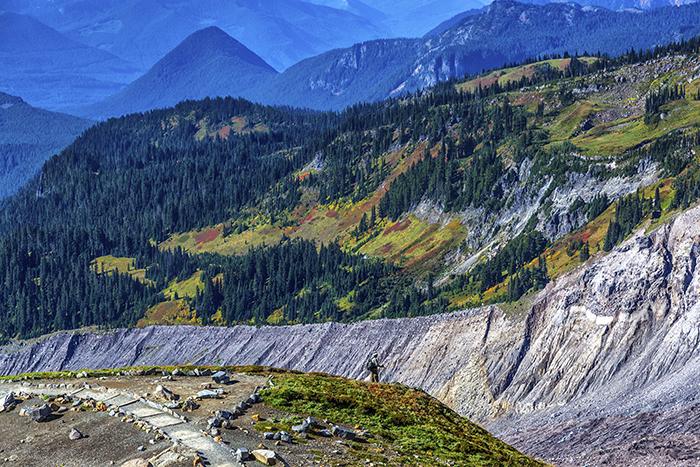
Taking in the view at Glacier Vista, Mount Rainier National Park / Rebecca Latson
On a sunny day, the view at Panorama Point requires a polarizing filter and either a lens hood or grad ND filter. On the fine, bright autumn day I stood at Panorama Point to capture the image below, the sun was in my line of sight and I did not use a lens hood, opting for a grad ND filter, instead. This resulted in little flare spots that I removed by cropping out some of the sky and making this panoramic image more of a - um - panorama. If you are faced with a similar situation, do what I did not: take a photo using your grad ND filter, then change your settings (because you won’t have that extra shade from a grad ND), affix a lens hood and take another photo. Make sure you have your polarizing filter on the lens. See which result you prefer.

The panorama at Panorama Point, Mount Rainier National Park / Rebecca Latson
Seasonal note: I stayed anywhere from 2-6 days in the Paradise area during each of my spring, summer and fall visits. What I saw, each time, was defined by the season. For example, while driving up to Paradise on a sunny April mid-morning, I assumed, rather naively, that I’d be able to maneuver around in just my hiking boots. Below are views of Paradise in the spring. Yeah – lots of snow. After “post holing” more than a few times, I realized I should have rented snowshoes back at the Longmire General Store. If you travel to Paradise in early spring, do as I say, here, and not as I did, back then.

Plowing snow in the spring at Paradise, Mount Rainier National Park / Rebecca Latson
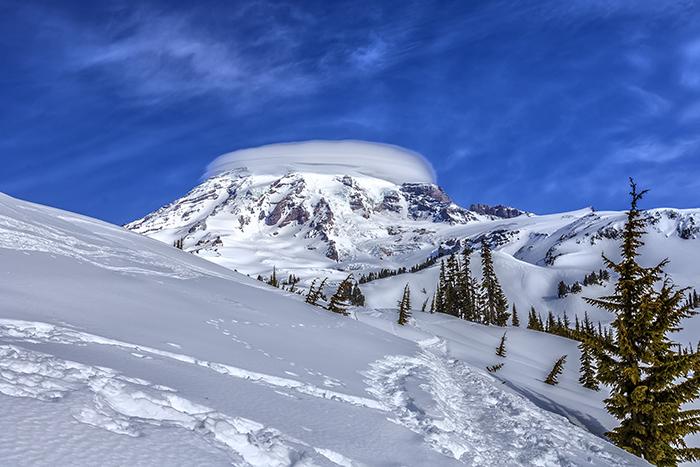
Paradise in the spring, Mount Rainier National Park / Rebecca Latson
Wildlife
Chances are good that you'll spy wildlife during your stay in Paradise. As you wander the trails, camera in hand, be observant of your surroundings. The wildlife is there, but you might overlook its presence. You might miss a tiny chipmunk sitting on some weeds as it nibbles on a seed pod. You might neglect to detect out of the corner of your eye a deer snacking on leaves, or miss hearing the chirrup of a blue grouse family pecking at the ground. You might not see the hoary marmot sitting statue-still on a large rock to the side of the trail. Stop occasionally and observe the scene in which you find yourself before continuing your hike.

Having a little snack, Mount Rainier National Park / Rebecca Latson

A deer in the drizzle, Mount Rainier National Park / Rebecca Latson
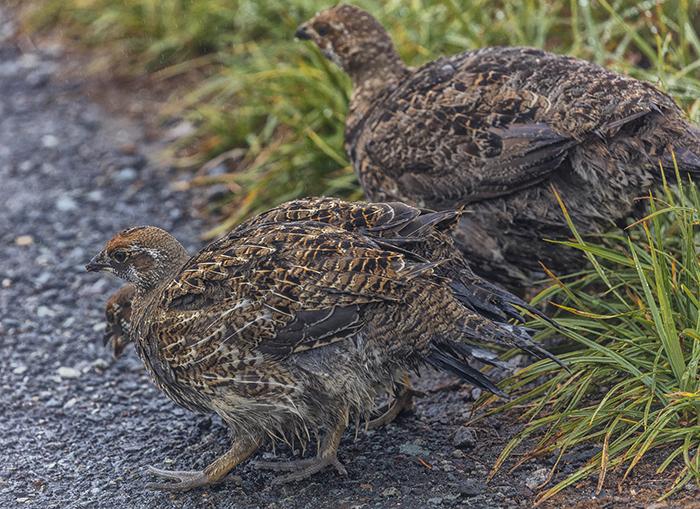
Blue grouse mother and chicks along the Alta Vista Trail, Mount Rainier National Park / Rebecca Latson

King of the hill at Paradise, Mount Rainier National Park / Rebecca Latson
For wildlife images, make sure to:
- Use a telephoto lens. For SLRs, you can get great images from a 70-200mm, 28-300mm or 100-400mm lens. In a pinch, even a 24-105mm will work. If you use one of the super-telephoto primes (500mm – 800mm) you really need a gimbal tripod for these heavy lenses. Turn on your lens or camera's image stabilization for handheld shots. Point & shoot cameras have a built-in telephoto, which you might want to have already set for quick action since wildlife doesn't always wait around for you to compose the perfect shot while zooming from wide-angle to telephoto.
- Use a camera with a fast fps (frame per second) count, if possible. This is an optional bullet point and no, you are not required to go out and purchase a fast camera if you don’t own one. If you wish, though, you can rent one for your trip from online sites like lensrentals.com, borrowlenses.com, and lensprotogo.com. A fast camera is great for applying the burst mode. You may joke about my “spray and pray” method, but when I visited Katmai National Park, I and every other photographer around me used the burst method when capturing shots of the Alaskan coastal brown bears. That fast fps really freezes the moment for a clear, sharp wildlife image.
- Set your camera’s focus mode to track movement. Canon calls it AI-Servo, Nikon calls this setting AF-C, Pentax calls it AF.C and Sony calls it AF-C.
- Focus on the eyes. Portrait photographers always focus on the eyes of their subjects, because it’s the eyes everybody tends to look at first. Wildlife head shots are portraits, too, you know.
- If you can't get a good close-up of your subject(s), incorporate your wildlife into the rest of your landscape. The surrounding landscape provides your viewers with a frame of reference and an idea about the type of environment in which the wildlife dwells.
Paradise Long-Term Parking Lot
If you’ve spent the night at the Paradise Inn and are leaving early in the morning, turn right, instead of left, drive down the road past the visitor center and turn right, again, to park your car in the long-term parking lot. Look across the road to the Tatoosh mountain range as the sun rises. There might be some mist or low-hanging clouds lingering from the previous night while the sun bathes portions of the landscape with a bright, golden glow. A circular polarizer saturates those morning colors and a grad ND filter prevents overexposure of the brightening sky.

Morning on the Tatoosh Range, Mount Rainier National Park / Rebecca Latson
While you’re at it, don’t forget to listen to the quietness of the land, gently punctuated with the occasional morning call of birdsong and the sound of running meltwater. The view and Nature’s music will be a nice sendoff as you prepare to drive down-elevation toward next month's Part 4: Longmire and the Nisqually entrance.



Comments
Thanks! I epecially value your Armchair Guides because they center on sites that are reasonably accessible to those of us whose mountain-goat skills are in the distant past. (Another way of saying those of us who are older than dirt.) Great practical advice. I look forward to the next one!
Ranier is still on my "bucket list". Thanks for your help and suggestions.
Thanks for the kind words! I truly believe everybody should be able to return from a national park visit with their own amazing images, no matter whether the shots are from a pullout or captured during a backcountry trip. So, I'm glad you find these Armchair Photography Guides helpful.
I'm planning my first trip to the mountain to stay at Paradise Inn and your article has been an invaluable resource for prioritizing my to do photography list for my 2 day stay. Thank you!